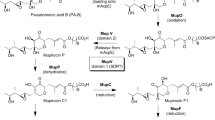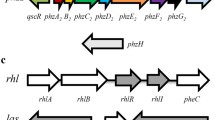Abstract
Transcription of the 74 kb Pseudomonas fluorescens mupirocin [pseudomonic acid (PA)] biosynthesis cluster depends on quorum sensing-dependent regulation via the LuxI/LuxR homologues MupI/MupR. To facilitate analysis of novel PAs from pathway mutants, we investigated factors that affect mup gene expression. First, the signal produced by MupI was identified as N-(3-oxodecanoyl)homoserine lactone, but exogenous addition of this molecule did not activate mupirocin production prematurely nor did expression of mupI in trans increase metabolite production. Second, we confirmed that mupX, encoding an amidase/hydrolase that can degrade N-acylhomoserine lactones, is also required for efficient expression, consistent with its occurrence in a regulatory module linked to unrelated genes in P. fluorescens. Third, and most significantly, mupR expression in trans to wild type and mutants can increase production of antibiotic and novel intermediates up to 17-fold.






Similar content being viewed by others
References
Birnboim HC, Doly J (1979) A rapid alkaline extraction procedure for screening recombinant plasmid DNA. Nucleic Acids Res 7:1513–1523
Cha C, Gao P, Chen YC, Shaw PD, Farrand SK (1998) Production of acyl-homoserine lactone quorum-sensing signals by Gram-negative plant-associated bacteria. Mol Plant Microbe Interact 11:1119–1129
Chhabra SR, Stead P, Bainton NJ, Salmond GPC, Stewart GSAB, Williams P, Bycroft BW (1993) Autoregulation of carbapenem biosynthesis in Erwinia carotovora ATCC 39048 by analogues of N-(3-oxohexanoyl)-l-homoserine lactone. J Antibiot 46:441–454
Chhabra SR, Philipp B, Eberl L, Givskov M, Williams P, Camara M (2005) Extracellular communication in bacteria. In: Schulz S (ed) Chemistry of pheromones and other semiochemicals. Springer, pp 279–315
Cohen SN, Chang ACY, Hsu H (1972) Non-chromosomal antibiotic resistance in bacteria; genetic transformation of Escherichia coli by R factor DNA. Proc Natl Acad Sci USA 69:2110–2114
Collins CH, Arnold FH, Leadbetter JR (2005) Directed evolution of Vibrio fischeri LuxR for increased sensitivity to a broad spectrum of acyl-homoserine lactones. Mol Microbiol 55:712–723
Cooper SM, Cox RJ, Crosby J, Crump MP, Hothersall J, Laosripaiboon W, Simpson TJ, Thomas CM (2005a) Mupirocin W, a novel pseudomonic acid produced by targeted mutation of the mupirocin biosynthetic gene cluster. Chem Commun 9:1179–1181
Cooper SM, Laosripaiboon W, Rahman AS, Hothersall J, El-Sayed AK, Winfield C, Crosby J, Cox RJ, Simpson TJ, Thomas CM (2005b) Shift to pseudomonic acid B production in P. fluorescens NCIMB 10586 by mutation of mupirocin tailoring genes mupO, mupU, mupV, and macpE. Chem Biol 12:825–833
Dong YH, Gusti AR, Zhang Q, Xu JL, Zhang LH (2002) Identification of quorum-quenching N-acyl homoserine lactonases from Bacillus species. Appl Environ Microbiol 68:1754–1759
Dong Y-H, Zhang X-F, Xu J-L, Zang Z-H (2004) Insecticidal Bacillus thuringiensis silences Erwinia carotovora virulence by a new form of microbial antagonism, signal interference. Appl Environ Microbiol 70:954–960
El-Sayed AK, Hothersall J, Thomas CM (2001) Quorum-sensing-dependent regulation of biosynthesis of the polyketide antibiotic mupirocin in Pseudomonas fluorescens NCIMB 10586. Microbiology 147:2127–2139
El-Sayed AK, Hothersall J, Cooper SM, Stephens E, Simpson TJ, Thomas CM (2003) Characterisation of the mupirocin biosynthesis gene cluster from Pseudomonas fluorescens NCIMB 10586. Chem Biol 10:419–430
Gornall AG, Bardawill CJ, David MM (1949) Determination of serum proteins by means of the biuret reaction. J Biol Chem 177:751–766
Gould TA, Herman J, Krank J, Murphy RC, Churchill MEA (2006) Specificity of acyl-homoserine lactone synthases examined by mass spectrometry. J Bacteriol 188:773–783
Hanahan D (1983) Studies on transformation of Escherichia coli with plasmids. J Mol Biol 166:557–580
Hothersall J, Wu J-E, Rahman AS, Shields JA, Haddock J, Johnson N, Cooper SM, Stephens E, Cox RJ, Crosby J, Willis CL, Simpson TJ, Thomas CM (2007) Mutational analysis reveals that all tailoring region genes are required for production of polyketide antibiotic mupirocin by Pseudomonas fluorescens: pseudomonic acid B biosynthesis precedes pseudomonic acid A. J Biol Chem 282:15451–15461
Huang JJ, Han JI, Zhang LH, Leadbetter JR (2003) Utilization of acyl-homoserine lactone quorum signals for growth by a soil Pseudomonad and Pseudomonas aeruginosa PAO1. Appl Environ Microbiol 69:5941–5949
Koch G, Jimenez PN, Muntendam R, Chen YX, Papaioannou E, Heeb S, Camara M, Williams P, Cool RH, Quax WJ (2010) The acylase PvdQ has a conserved function among fluorescent Pseudomonas spp. Environ Microbiol Rep 2:433–439
Laue BE, Jiang Y, Chhabra SR, Jacob S, Stewart GSAB, Hardman A, Downie JA, O’Gara F, Williams P (2000) The biocontrol strain Pseudomonas fluorescens F113 produces the Rhizobium small bacteriocin, N-(3-hydroxy-7-cis-tetradecenoyl) homoserine lactone, via HdtS, a putative novel N-acylhomoserine lactone synthase. Microbiology 146:2469–2480
Leadbetter JR, Greenberg EP (2000) Metabolism of acyl-homoserine lactone quorum-sensing signals by Variovorax paradoxus. J Bacteriol 182:6921–6926
Lin YH, Xu JL, Hu J, Wang LH, Ong SL, Leadbetter JR, Zhang LH (2003) Acyl-homoserine lactone acylase from Ralstonia strain XJ12B represents a novel and potent class of quorum-quenching enzymes. Mol Microbiol 47:849–860
Maurhofer M, Baehler E, Notz R, Martinez V, Keel C (2004) Cross talk between 2, 4-diacetylphloroglucinol-producing biocontrol Pseudomonads on wheat roots. Appl Environ Microbiol 70:1990–1998
McClean KH, Winson MK, Fish L, Taylor A, Chhabra SR, Camara M, Daykin M, Lamb JH, Swift S, Bycroft BW, Stewart GS, Williams P (1997) Quorum sensing and Chromobacterium violaceum: exploitation of violacein production and inhibition for the detection of N-acylhomoserine lactones. Microbiology 143:3703–3711
Moir A, Lafferty E, Smith DA (1979) Genetic analysis of spore germination mutants of Bacillus subtilis 168, the correlation of phenotype with map location. J Gen Microbiol 111:165–168
Nakata K, Yoshimoto A, Yamada Y (1999) Promotion of antiobiotic by high ethanol, high NaCl concentration, or heat shock in Pseudomonas fluorescens S272. Biosci Biotechnol Biochem 63:293–297
Oliynyk M, Stark CBW, Bhatt A, Jones MA, Hughes-Thomas ZA, Wilkinson C, Oliynyk Z, Demydchuk Y, Staunton J, Leadlay PF (2003) Analysis of the biosynthetic gene cluster for the polyether antibiotic monensin in Streptomyces cinnamonensis and evidence for the role of monB and monC genes in oxidative cyclization. Mol Microbiol 49:1179–1190
Ortori CA, Atkinson S, Chhabra SR, Camara M, Williams P, Barret DA (2007) Comprehensive profiling of N-acylhomoserine lactones produced by Yersinia pseudotuberculosis using liquid chromatography coupled to hybrid quadrupole-linear ion trap mass spectrometry. Anal Bioanal Chem 387:497–511
Parsek MR, Val DL, Hanzelka BL, Conran JE Jr, Greenberg EP (1999) Acyl homoserine-lactone quorum-sensing signal generation. Proc Natl Acad Sci USA 1999:4360–4365
Schaefer AL, Val DL, Hanzelka BL, Conran JE Jr, Greenberg EP (1996) Generation of cell-to-cell signals in quorum sensing: acyl homoserine lactone synthase activity of a purified Vibrio fischeri LuxI protein. Proc Natl Acad Sci USA 93:9505–9509
Shaw PD, Ping G, Daly SL, Cha C, Cronan JE Jr, Rinehart KL, Farrand SK (1997) Detecting and characterizing N-acylhomoserine lactone signal molecules by thin-layer chromatography. Proc Natl Acad Sci USA 94:6036–6041
Simon R, Priefer U, Puhler A (1983) A broad host range mobilization system for in vivo genetic-engineering-transposon mutagenesis in Gram-negative bacteria. Biotechnol NY 1:784–791
Stratigopoulos G, Bate N, Cundliffe E (2004) Positive control of tylosin biosynthesis: pivotal role of TylR. Mol Microbiol 54:1326–1334
Swift S, Karlyshev AV, Fish L, Durant EL, Winson MK, Chhabra SR, Williams P, MacIntyre S, Stewart G (1997) Quorum sensing in Aeromonas hydrophila and Aeromonas salmonicida: identification of the LuxRI homologs AhyRI and AsaRI and their cognate N-acylhomoserine lactone signal molecules. J Bacteriol 179:5271–5281
Uroz S, Chhabra SR, Camara M, Williams P, Oger P, Dessaux Y (2005) N-acylhomoserine lactone quorum-sensing molecules are modified and degraded by Rhodococcus erythropolis W2 by both amidolytic and novel oxidoreductase activities. Microbiology 151:3313–3322
Watson WT, Minogue TD, Val DL, von Bodman SB, Churchill MEA (2002) Structural basis and specificity of acyl-homoserine lactone signal production in bacterial quorum sensing. Mol Cell 9:685–694
Wei HL, Zhang LQ (2006) Quorum-sensing system influences root colonization and biological control ability in Pseudomonas fluorescens 2P24. Antonie Leeuwenhoek 89:267–280
Whatling CA, Hodgson JE, Burnham MKR, Clarke NJ, Franklin FCH, Thomas CM (1995) Identification of a 60 kb region of the chromosome of Pseudomonas fluorescens NCIB 10586 required for the biosynthesis of pseudomonic acid (mupirocin). Microbiology 141:973–982
Williams P, Bainton NJ, Swift S, Chhabra SR, Winson MK, Stewart G, Salmond GPC, Bycroft BW (1992) Small molecule-mediated density-dependent control of gene-expression in prokaryotes—bioluminescence and the biosynthesis of carbapenem antiobiotics. FEMS Microbiol Lett 100:161–167
Winson MK, Swift S, Fish L, Throup JP, Jorgensen F, Chhabra SR, Bycroft BW, Williams P, Stewart G (1998) Construction and analysis of luxCDABE-based plasmid sensors for investigating N-acyl homoserine lactone-mediated quorum sensing. FEMS Microbiol Lett 163:185–192
Wu J, Cooper SM, Cox RJ, Crosby J, Hothersall J, Simpson TJ, Thomas CM, Willis CL (2007) Mupirocin H, a novel metabolite resulting from mutation of the HMG-CoA synthase analogue, mupH in Pseudomonas fluorescens. Chem Commun 20:2040–2042
Wu J, Hothersall J, Mazzetti C, O’Connell Y, Shields JA, Rahman AS, Cox RJ, Crosby J, Simpson TJ, Thomas CM, Willis CL (2008) In vivo mutational analysis of the mupirocin gene cluster reveals labile points in the biosynthetic pathway: the “Leaky Hosepipe” mechanism. Chembiochem 9:1500–1508
Zhang HB, Wang LH, Zhang LH (2002) Genetic control of quorum-sensing signal turnover in Agrobacterium tumefaciens. Proc Natl Acad Sci USA 99:4638–4643
Zukowski MM, Gaffney DF, Speck D, Kauffman M, Findelli A, Wisecup A, Lecocq JP (1983) Chromogenic identification of genetic regulatory signals in Bacillus subtilis based on expression of a cloned Pseudomonas gene. Proc Natl Acad Sci USA 80:1101–1105
Acknowledgement
This work was supported by BBSRC grants P15257 and P07071, BBSRC/EPSRC grant E021611 employing JH, ES and AM, as well as EPSRC grant S78124 that employed JW. GC was supported by a University of Nottingham Studentship and work in PW’s laboratory was supported by BBSRC. DNA sequencing was performed by the JIF-funded Genomics Laboratory in the School of Biosciences (6/JIF13209). HPLC/LCMS equipment was funded by EPSRC grant EP/F066104). We thank Miguel Camara at the University of Nottingham for his input and comments and Ram Chhabra and Alex Truman for AHL synthesis.
Author information
Authors and Affiliations
Corresponding author
Electronic supplementary material
Below is the link to the electronic supplementary material.
Fig. S1
Mupirocin 74 kb gene cluster organisation. Deduced open reading frame (ORF) functions are shown in the table. Polyketide synthase (PKS), ketosynthase (KS), acyl carrier protein (ACP), ketoreductase (KR), dehydratase (DH), thioesterase (TE), acyltransferase (AT), C-methyltransferase (MeT), 3-hydroxy-3-methylglutaric acid (HMG), phosphopantetheinyl transferase (PPTase), N-acyl homoserine lactone (N-AHL) (PDF 265 kb)
Fig. S2
Positive electrospray FT-ICR MS analysis of supernatant extracts from Escherichia coli with either expression plasmid pJH1 containing mupI or pJH10 with no insert revealed a peak at m/z 270.1699 (C14H24O4N1), which corresponds to 3-O-C10-HSL, present in E. coli (pJH1) but not E. coli (pJH10) (PDF 321 kb)
Fig. S3
Positive electrospray FT-ICR MS analysis of chemically synthesised 3-O-C10-HSL revealed a peak at m/z 270.1701 (PDF 195 kb)
Fig. S4
Positive electrospray FT-ICR MS analysis of solvent extracts from WT Pseudomonas fluorescens and mupI mutant revealed a peak at m/z 270.1699 corresponding to 3-O-C10-HSL in the WT sample but not the mupI mutant sample (PDF 225 kb)
Fig. S5
AHL degradation by Escherichia coli expressing mupX. Activity of E. coli (pSCCX; lanes 1 and 2), E. coli (pJH10) vector control (lanes 3 and 4) against a range of AHLs with acyl chains from C4 to C14 with or without a 3-oxo-substituent. The positive (lanes 5 and 6) and negative controls (lanes 7 and 8), respectively, contained AHLs only or the AHL reporters in the absence of AHLs. The E. coli pSB536 AHL biosensor did not respond to 3-oxo-C4-HSL (PDF 280 kb)
Table S1
Structural elucidation of PAs A7 (1) and B7 (2) (PDF 31 kb)
Rights and permissions
About this article
Cite this article
Hothersall, J., Murphy, A.C., Iqbal, Z. et al. Manipulation of quorum sensing regulation in Pseudomonas fluorescens NCIMB 10586 to increase mupirocin production. Appl Microbiol Biotechnol 90, 1017–1026 (2011). https://doi.org/10.1007/s00253-011-3145-2
Received:
Revised:
Accepted:
Published:
Issue Date:
DOI: https://doi.org/10.1007/s00253-011-3145-2




